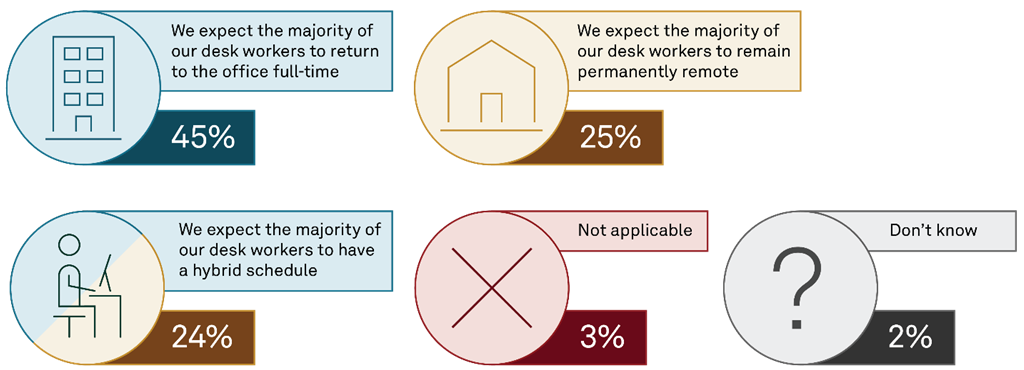S&P Global Offerings
Featured Topics
Featured Products
Events
S&P Global Offerings
Featured Topics
Featured Products
Events
S&P Global Offerings
Featured Topics
Featured Products
Events
Banking & Capital Markets
Economy & Finance
Energy Transition & Sustainability
Technology & Innovation
Podcasts & Newsletters
Banking & Capital Markets
Economy & Finance
Energy Transition & Sustainability
Technology & Innovation
Podcasts & Newsletters
S&P Global Offerings
Featured Topics
Featured Products
Events
Research — 9 Mar, 2023
Work-life balance difficulties remain a challenge from the beginning of the COVID-19 outbreak, but our latest survey results signal a shift in focus from short-term human factors — i.e., the impact of lockdowns and remote work on employees in the early days of the pandemic — to an emphasis on adopting a long-term view. These changes reflect a deep transition underway from legacy work practices to new approaches in work planning and execution characterized by increased flexibility, agility and business focus.
Explore key themes from responses to our Voice of the Enterprise: Workforce Productivity & Collaboration survey below.
Flexible work arrangements are here to stay
Nearly three years since the COVID-19 outbreak, survey results show that hybrid and remote work will remain relevant for many organizations and employees. Nearly half (49%) of survey respondents expect a majority of desk workers in their organization will be working remotely full time (25%) or have a hybrid schedule (24%) a year from now, while 45% expect the majority of desk workers will return to the office full time.

Source: Q: A year from now, does your organization expect the majority of its desk workers to be remote full-time or in-office full-time? Base: All respondents (n=500). 451 Research’s Voice of the Enterprise: Workforce Productivity & Collaboration, Technology Ecosystems 2022.
The physical office is transitioning into a collaborative space
As they transition to a hybrid work model, organizations are rethinking physical office space and reassessing the square footage they need. Nearly one in four (23%) survey respondents says their organization reduced its physical office footprint over the past 12 months. However, hybrid work entails a shift to a dynamic, flexible workspace — rather than a straightforward reduction in square footage. Our research shows that organizations are shifting away from individual cubicles and offices and embracing collaborative spaces. About one-quarter (26%) of respondent organizations added space for employees to work together (e.g., meeting and huddle rooms), while 24% added on-site spaces for employees to socialize (e.g., cafeteria, coffee bar) over the past 12 months.
New challenges emerge with the shift to hybrid work
Hybrid work is not simply a continuation of the remote work phase from the early days of the pandemic; rather, it is a different phase presenting new challenges. Survey results show this transition remains a work in progress. More than half (60%) of survey respondents believe that supporting a distributed workforce over the next two years will be significantly (22%) or somewhat (38%) challenging for their organization. Those respondents cite team building (38%), keeping employees focused and aligned (36%), work-life balance difficulties (36%), and having the technologies to effectively support remote work (35%) as the top challenges their organization will face in supporting a distributed workforce.
To learn more about what our experts expect to see this year, download our 2023 Trends in Workforce Productivity and Collaboration report.
Research
Research

